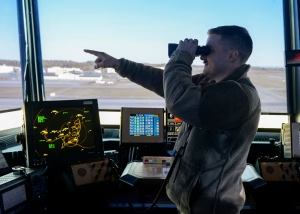 In this video presentation, I examine the crisis bedeviling the U.S. Air Traffic Control (ATC) system. Click here to view my video: https://shorturl.at/2bHSD
In this video presentation, I examine the crisis bedeviling the U.S. Air Traffic Control (ATC) system. Click here to view my video: https://shorturl.at/2bHSD
Below is an edited transcript of my presentation.
If you’re waiting for the U.S. government to fix the ATC crisis, pack a lunch and bring a sleeping bag. It might be a long while. Fortunately, while politicians fumble and bureaucrats bloviate, a few savvy companies are quietly stepping in to drag America’s skies into the 21st century.
Yes, the nation’s aviation infrastructure is a shambles. But there’s a source of hope: Private sector avionics firms are stepping into the breach. They’re building smarter solutions, better situational awareness tools, and resilient backup systems designed to function even when government infrastructure fails.
In the meantime, the U.S. ATC system is collapsing in slow motion, and no one in Washington seems particularly interested in pulling the nose up.
The fatal mid-air collision in January over the Potomac, when a Black Hawk helicopter collided with a commercial airliner in Washington, DC airspace, was a long-dreaded ATC failure that experts say was inevitable. Antiquated radar, overwhelmed controllers, and a broken chain of command combined to deliver a preventable catastrophe. This wasn’t just a tragedy. It was a warning.
Antiquated technology…
The root of the problem lies with the Federal Aviation Administration (FAA), an agency so chronically underfunded and mismanaged it might as well be running on vacuum tubes. Much of the equipment in use dates back to the 1970s. The radar screens look like Cold War relics because they are Cold War relics. Staffing levels are so low that controllers routinely pull double and even triple shifts. Burnout isn’t a risk—it’s a given.
The FAA’s problems predate the second Trump administration (and even the first), but severe budget slashes under Trump 2.0 are exacerbating the mess. Essential roles in ATC are being left vacant. The FAA is overwhelmed, under-equipped, and paralyzed.
When the Department of Transportation (DoT) handed the keys to Sean Duffy—a former reality TV personality with zero aviation experience—hopes for reform became little more than punchlines. The only thing soaring right now is public anxiety.
Just ask travelers at Newark Liberty International Airport, one of the busiest hubs in the nation, where delays have turned into full-blown meltdowns. Taxi times stretch into hours. Gate changes occur mid-taxi. Departures stall because there’s no one available to guide takeoff traffic. Travelers are now making efforts to avoid the airport altogether.
What’s happening in Newark isn’t a one-off glitch. It’s a preview of the future unless serious technological upgrades are made, and fast.
According to recent polling, about 65% of Americans say they are more nervous about flying due to ATC issues. That’s not just a public relations problem. It’s a commercial aviation crisis.
Carriers can’t schedule reliably if ATC is in disarray. Crew timing rules clash with delayed departures, stranding aircraft and creating a cascade of cancellations. Every delay costs money and passengers. Some are now opting for trains, buses, or not traveling at all. The system is bleeding confidence.
And while Sean Duffy insists all is well from his perch atop the DoT—when he’s not reprising his old soundbites from “Real World: Boston”—industry insiders know better. The FAA is a bureaucracy adrift.
The controller shortage is now critical, with some regional towers staffed at just 60% of operational need. Upgrades to essential software have been delayed by years. The system is one lightning strike or ransomware attack away from collapse.
Unless the government makes an aggressive and well-funded effort to fix the ATC system, aviation will be plagued by safety risks and economic headwinds for years to come.
In successive articles and video presentations within this e-letter, I will examine what’s being done to mitigate the crisis.